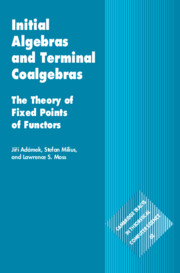7066 results
The Feminized Hero in Second Temple Judaism
- Coming soon
-
- Expected online publication date:
- October 2024
- Print publication:
- 31 October 2024
-
- Book
- Export citation

Initial Algebras and Terminal Coalgebras
- The Theory of Fixed Points of Functors
- Coming soon
-
- Expected online publication date:
- September 2024
- Print publication:
- 30 September 2024
-
- Book
- Export citation
Three Consuls
- Capitalism, Empire, and the Rise and Fall of America's Mediterranean Community, 1776–1840
- Coming soon
-
- Expected online publication date:
- September 2024
- Print publication:
- 30 September 2024
-
- Book
- Export citation
Effect of herbicide programs on control and seed production of multiple herbicide-resistant Palmer amaranth (Amaranthus palmeri) in corn resistant to 2,4-D/glufosinate/glyphosate
-
- Journal:
- Weed Technology / Accepted manuscript
- Published online by Cambridge University Press:
- 16 April 2024, pp. 1-28
-
- Article
-
- You have access
- Open access
- Export citation
Geographical variation in medication and health resource use in multiple sclerosis
-
- Journal:
- Canadian Journal of Neurological Sciences / Accepted manuscript
- Published online by Cambridge University Press:
- 11 April 2024, pp. 1-21
-
- Article
- Export citation
73 Use of Probabilistic Linkage to Create a Novel Database to Study the Care of Bronchiolitis in Pediatric Intensive Care Units (PICU)
- Part of
-
- Journal:
- Journal of Clinical and Translational Science / Volume 8 / Issue s1 / April 2024
- Published online by Cambridge University Press:
- 03 April 2024, p. 19
-
- Article
-
- You have access
- Open access
- Export citation
Talc in the Suspended Matter of the Northwestern Atlantic
-
- Journal:
- Clays and Clay Minerals / Volume 31 / Issue 1 / February 1983
- Published online by Cambridge University Press:
- 02 April 2024, pp. 60-64
-
- Article
- Export citation
Metastability in Near-Surface Rocks of Minerals in The System Al2O3-SiO2-H2O
-
- Journal:
- Clays and Clay Minerals / Volume 39 / Issue 3 / June 1991
- Published online by Cambridge University Press:
- 02 April 2024, pp. 225-233
-
- Article
- Export citation
Mössbauer Spectroscopic Study of the Iron Mineralogy of Post-Glacial Marine Clays
-
- Journal:
- Clays and Clay Minerals / Volume 34 / Issue 3 / June 1986
- Published online by Cambridge University Press:
- 02 April 2024, pp. 314-322
-
- Article
- Export citation
Provisioning urbanism: a comparative urban-rural zooarchaeology of ancient Southwest Asia
-
- Article
-
- You have access
- Open access
- HTML
- Export citation
Poststroke Care Pathways and Spasticity Treatment: A Retrospective Study in Alberta
-
- Journal:
- Canadian Journal of Neurological Sciences , First View
- Published online by Cambridge University Press:
- 22 March 2024, pp. 1-10
-
- Article
-
- You have access
- Open access
- HTML
- Export citation
31 - Antiracist Moral and Civic Education
- from Part III - Emerging Ethical Pathways and Frameworks
-
-
- Book:
- The Cambridge Handbook of Ethics and Education
- Published online:
- 07 March 2024
- Print publication:
- 14 March 2024, pp 657-675
-
- Chapter
- Export citation
Impact of a syndrome-based stewardship intervention on antipseudomonal beta-lactam use, antimicrobial resistance, C. difficile rates, and cost in a safety-net community hospital
-
- Journal:
- Antimicrobial Stewardship & Healthcare Epidemiology / Volume 4 / Issue 1 / 2024
- Published online by Cambridge University Press:
- 13 March 2024, e31
-
- Article
-
- You have access
- Open access
- HTML
- Export citation
A new MIS 5 to MIS 2 speleothem record from Sandkraal Cave on the South African Cape south coast
-
- Journal:
- Quaternary Research / Volume 118 / March 2024
- Published online by Cambridge University Press:
- 12 March 2024, pp. 142-161
-
- Article
-
- You have access
- Open access
- HTML
- Export citation
Multitask feature selection within structural datasets
-
- Journal:
- Data-Centric Engineering / Volume 5 / 2024
- Published online by Cambridge University Press:
- 07 March 2024, e4
-
- Article
-
- You have access
- Open access
- HTML
- Export citation
Spray interval, application order, and plant height influences control of dicamba-resistant Palmer amaranth
-
- Journal:
- Weed Technology / Volume 38 / 2024
- Published online by Cambridge University Press:
- 26 February 2024, e22
-
- Article
-
- You have access
- Open access
- HTML
- Export citation
Tropical vegetation productivity and atmospheric methane over the last 40,000 years from model simulations and stalagmites in Sulawesi, Indonesia
-
- Journal:
- Quaternary Research / Volume 118 / March 2024
- Published online by Cambridge University Press:
- 26 February 2024, pp. 126-141
-
- Article
-
- You have access
- Open access
- HTML
- Export citation
An analysis of the transformative potential of Australia’s national food policies and policy actions to promote healthy and sustainable food systems
-
- Journal:
- Public Health Nutrition / Volume 27 / Issue 1 / 2024
- Published online by Cambridge University Press:
- 20 February 2024, e75
-
- Article
-
- You have access
- Open access
- HTML
- Export citation
The usability and reliability of a smartphone application for monitoring future dementia risk in ageing UK adults
-
- Journal:
- The British Journal of Psychiatry , FirstView
- Published online by Cambridge University Press:
- 15 February 2024, pp. 1-7
-
- Article
-
- You have access
- Open access
- HTML
- Export citation
Financing Negative Shocks: Evidence from Hurricane Harvey
-
- Journal:
- Journal of Financial and Quantitative Analysis / Accepted manuscript
- Published online by Cambridge University Press:
- 12 February 2024, pp. 1-84
-
- Article
- Export citation




